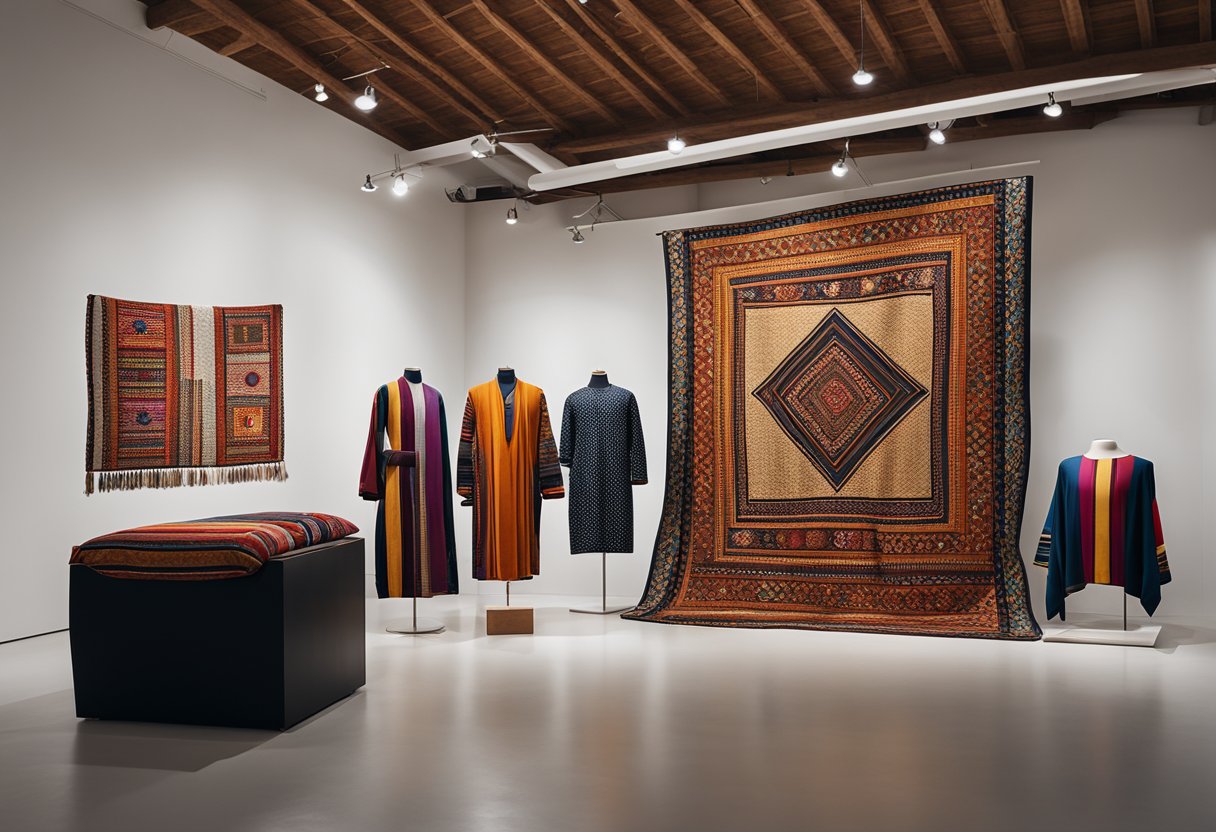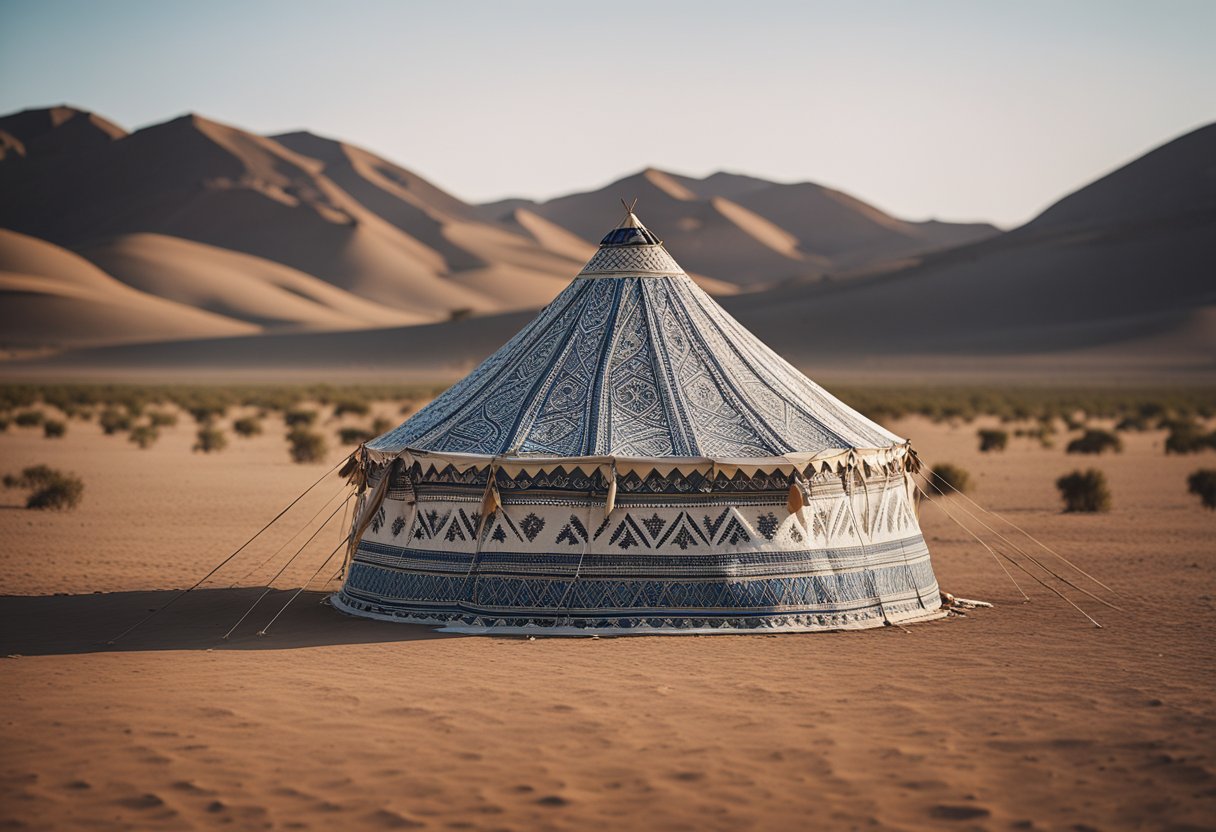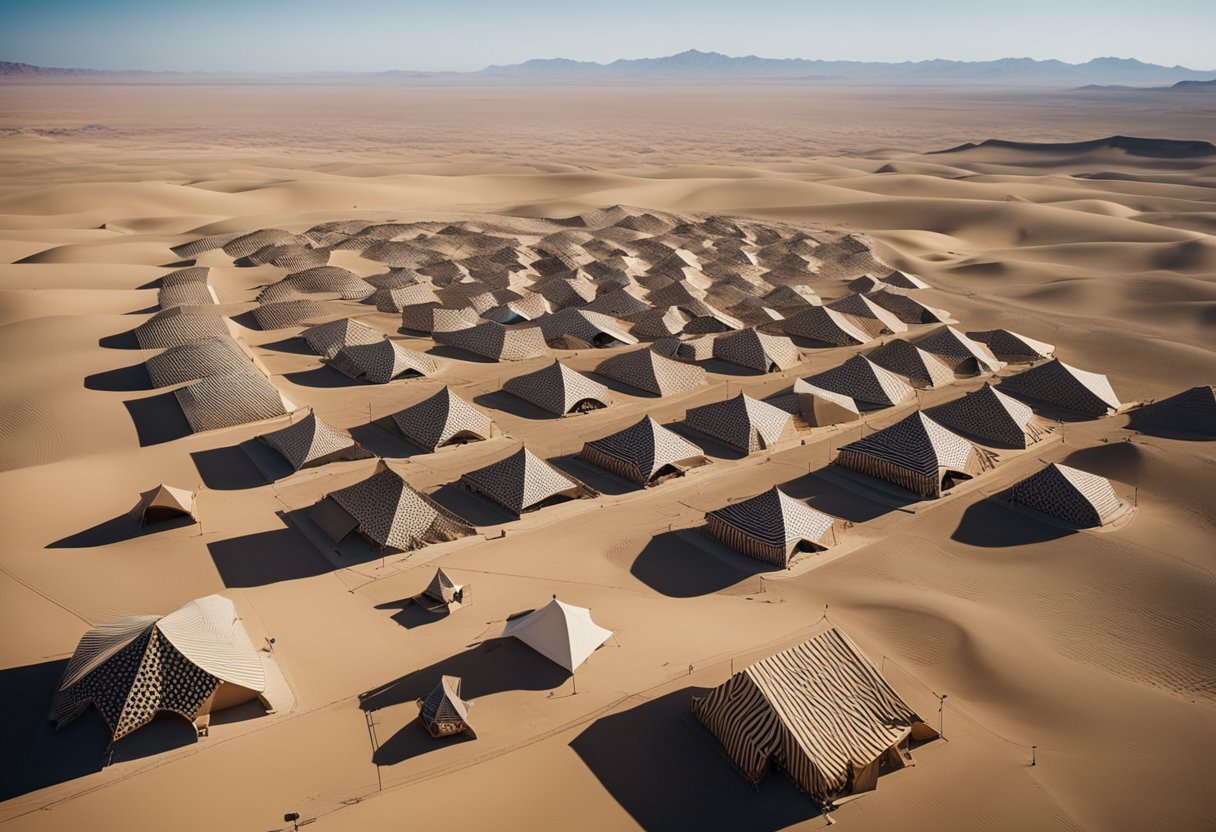The Influence of Nomadic Cultures on Modern Art and Design

Updated On: April 23, 2024 by Raghda Elsabbagh
In viewing the tapestry of global art and design, the threads woven by nomadic cultures are particularly vibrant and influential. With a history rich in movement and a diverse social structure, these cultures harbour unique perspectives that seep into contemporary art and design realms. Nomadism, characterised by its virtues of freedom and mobility, offers an alternative narrative to the sedentary lifestyles that dominate modern society. The artistic expressions derived from nomadic life not only call to us with their aesthetic appeal but also compel us to reflect on themes of cultural identity, adaptability, and resilience.

Nomadic influences in today’s creative fields are apparent, as contemporary artists and designers frequently reference the fluidity and flexibility inherent in a nomadic way of life. These references materialise through the use of sparse, multifunctional elements, moving away from the permanence of traditional forms. At the same time, the spirituality of nomadic cultures often manifests in the art world, lending an ethereal quality to the material world.
Furthermore, the economic aspects and social symbolism of these cultures continue to raise questions and inspire dialogue, ensuring that the conversation around nomadism remains dynamic and evolving. We see the fusion of these nomadic traits with modern techniques and technologies, resulting in novel avenues of creativity that redefine our environment and how we interact with it.
Table of Contents
Historical Context of Nomadic Cultures
In our exploration, we understand that nomadic cultures have historically shaped societies through their unique way of life, influencing various aspects, including contemporary art and design.
Nomadism in Central Asia
Central Asia has long been the heartland of nomadic peoples who mastered the art of survival across its vast steppes. Nomadism, a lifestyle characterised by seasonal movement rather than permanent settlement, allowed these populations to thrive in harmony with nature’s rhythm. The pastoral nomads of this region followed a cyclic existence, moving their herds to optimise access to pastures throughout the year, a way of life sharply contrasting with settled agricultural communities.
The Scythians and the Altai Mountains
The Scythians, a prominent nomadic group in history, roamed the steppes from what is now southern Siberia to Eastern Europe. Famous for their prowess in horseback riding and metalwork, they left a rich archaeological legacy in the Altai Mountains. These mountains, located in the vicinity of modern-day Russia, Kazakhstan, China, and Mongolia, served as an essential burial site for the Scythian elites, where permafrozen kurgans have preserved the intricate artefacts and complex animal motifs indicative of their culture.
Nomadic Influence on 19th-Century Europe
In the 19th century, Europe witnessed a growing fascination with nomadic cultures. This period saw the Orientalist movement take shape, where artists and designers drew inspiration from the perceived exoticism and freedom of the nomadic lifestyle. The adaptation of vibrant patterns, motifs, and the romanticism of nomadic life greatly influenced the bohemian movements of the time. It was an artistic response that sought to eschew the rigidity of industrialisation by embracing the fluidity and dynamism inherent in nomadic culture.
Nomadic Culture and Social Structure

Nomadic societies have intricate social structures that are deeply rooted in their cultural practices. These structures play a pivotal role in their daily lives, from defining social hierarchy to determining individual roles and status.
Hierarchy and Nobility
In nomadic cultures, the concept of hierarchy is evident, though it may differ from sedentary societies. Leadership is often based on attributes such as experience, wisdom, and warrior skills. Nobility within these communities is not just an inherited status but can also be achieved through personal deeds and the ability to guide and protect the group.
Women’s Roles and Status
Women play crucial roles in nomadic societies, and their status often varies. While some nomadic women may enjoy considerable autonomy and influence, in other cultures, gender roles are more traditional. Women’s responsibilities often extend beyond domestic spheres, involving them in vital community and economic activities.
Marital Indicators and Decorations
Marital status in nomadic cultures is frequently signalled through decorations such as jewellery or clothing. These items are not merely ornamental; they are imbued with cultural significance, signifying a person’s marital history and social position within the community. Such decorations can be a source of pride and a visual language understood by the group.
Artistic Expressions of Nomadic Life
Nomadic cultures have long harnessed textiles, adornments, and architecture to reflect their heritage, social status, and environmental adaptation. These art forms not only serve practical purposes but also stand as testaments to nomadic aesthetics and ingenuity.
Textiles and Clothing
Textiles are a cornerstone of nomadic art, often telling stories through intricate patterns and vibrant colours. The texture and design of nomadic clothing are tailored to suit the demanding lifestyles of these communities, with materials like wool and leather offering both durability and comfort. Decorative elements, such as embroidery and beadwork, imbue garments with cultural significance, transforming practical attire into works of movable art.
- Texture: Utilises robust, natural fabrics.
- Pattern: Exhibits elaborate, symbolic designs.
Jewellery and Adornments
Nomadic jewellery doubles as both personal ornamentation and portable wealth. Crafted from precious metals and gems, these pieces are often rich in detail and heavily influenced by the nomads’ natural surroundings. Headpieces, amulets, and other adornments carry deep communal and spiritual meanings, signifying milestones such as marriage or rites of passage.
- Materials: Typically made from silver, gold, and semi-precious stones.
- Function: Denotes social status and personal identity.
Tents and Portable Architecture
Tents and other forms of portable architecture embody the essence of nomadic design, balancing the need for mobility with the desire for aesthetic expression. Made from materials like animal hides and woven fabrics, these structures are both functional and symbolic, often decorated with geometric patterns that hold cultural value.
- Design: Focuses on easy assembly, disassembly, and transport.
- Decoration: Features ornate, culturally resonant motifs.
Influence on Modern Design and Architecture
In examining the impact of nomadic cultures on modern aesthetics, one can observe a distinct influence in both design principles and architectural innovation, rooted in the necessity for function and an appreciation for mobility and adaptability.
Functionalism in Design
We find that functionalism has become a core principle in modern design, championed for its focus on practicality and efficiency. This ethos aligns seamlessly with the nomadic requirement for portable and multipurpose objects, where every item must serve a clear purpose and be easily transportable. Designers often draw inspiration from the simplicity and versatility found in nomadic cultures, redefining originality in the context of everyday items by prioritising their functionality without compromising aesthetics.
Nomadic Elements in Contemporary Architecture
In contemporary architecture, the influence of nomadic life is evident in structures that embrace flexibility, modularity, and a connection with the environment. Architects often incorporate engineering techniques that enable buildings to adapt to various needs and climates, reminiscent of the nomadic ability to settle and thrive in diverse settings. The use of lightweight materials, open layouts, and transportable modules reflects a modern interpretation of the nomadic lifestyle, striving for a balance between transient functionality and permanent presence.
Spirituality and Artistic Expression

Spirituality serves as a profound wellspring for contemporary art, where religious symbols and rituals extend beyond their traditional contexts to imbue artworks with layered meanings. Our exploration encompasses the specific ways in which these elements manifest within painting and design to reflect the cultural and spiritual zeitgeist.
Religious Symbols and Motifs
Religious symbols have long been intertwined with cultural expressions, and their incorporation into contemporary art reflects a continued fascination with spiritual narratives. For instance, the use of Christian iconography in paintings might challenge or reflect upon modern values, while Buddhist mandalas represent a cosmic diagram that reminds viewers of their relation to infinity. These symbols, mined from myriad religious contexts, are not merely decorative but are laden with history and spiritual significance.
Ritualistic Articles and Artefacts
In the realm of the tangible, ritualistic articles and artefacts hold a special place within art and design. Contemporary artists often repurpose these objects to offer commentary on cultural practices or to evoke spiritual experiences in viewers. For example, a modern installation might feature prayer beads or shamanistic masks, translating their original purposes into contemporary artistic dialogues. Whether through direct representation or abstract inspiration, these artefacts bring the essence of the nomadic and the sacred into art spaces, merging the ancient with the avant-garde.
Exhibitions and Collections

In our exploration of nomadic cultures’ impact on contemporary art and design, we focus on two pivotal elements: Museums and Art Exhibition Spaces and the Role of Exhibitions in Cultural Preservation. Through curated displays and thoughtful presentations, these venues and events become vital conduits for sharing and sustaining the visual narratives of nomadic life.
Museums and Art Exhibition Spaces
Museums:
- Function: Serve as custodians of cultural heritage, housing permanent collections and hosting temporary exhibitions.
- Examples: The Mingei International Museum celebrates nomadic cultures through their rich artistic heritage, including exhibitions like ‘Nomadic Legacy’.
Art Exhibition Spaces:
- Locations: Spread globally; notable for their diversity and adaptability.
- Beijing Influence: Contemporary art offices like PLAT ASIA incorporate nomadic ethos within urban environments, linking ancient traditions and the modern cityscape.
Role of Exhibitions in Cultural Preservation
Exhibitions play an essential role in preserving the transient and often endangered aspects of nomadic life. By showcasing artefacts and artworks, they:
- Educate: Inform the public about the history, craftsmanship, and social structures of nomadic societies.
- Preserve: Act as a record for vanishing traditions, as highlighted by Adornment: Jewelry of South Asia’s Nomadic Cultures, elevating the recognition of historically nomadic cultures.
Nomadic Culture in Literature and Publications

Exploring the deep connections between nomadic cultures and contemporary art and design, we find a rich array of literature that offers insights into these influential societies. Let’s delve into notable essays and catalogues that showcase the impact of nomadic life on art and design.
Essays on Nomadism
In the realm of academic discourse, essays on nomadism provide critical analysis and engage with the complexities of nomadic influence on cultural development. For instance, the edited volume Nomads as Agents of Cultural Change examines the role of nomads across various regions, including Mongolia, Iran, and Syria, highlighting the transcultural impacts of their movements and interactions. The discussions within this text reflect a multifaceted view of nomadic contributions to Eurasian history and, subsequently, to the artistic narrative that threads through art history.
Within African studies, essays often concentrate on the intersection of nomadic lifestyles and the continent’s artistic evolution. The cultural practices and aesthetic principles originating from Africa’s nomadic communities have informed contemporary art and design in profound ways, inspiring innovative expressions that resonate in today’s global art scene.
Catalogues of Nomadic Art
Catalogues of nomadic art hold a special place by visually representing the artistic output connected with nomadic cultures. These publications are not only informative compilations but also serve as exhibits themselves, often associated with museums or galleries. As artefacts, these catalogues become art historical documents that chronicle the journey of nomadic aesthetic influence across centuries and continents.
In our own compilations, we aim to encapsulate the essence of nomadic art, featuring collections that range from textiles and jewellery to architectural elements and more. We take pride in meticulously curating these pieces, ensuring a diverse and representative sample that does justice to the nomadic spirit, which is still alive in many forms of modern design. Through catalogues, we preserve and celebrate this ongoing narrative, fostering a greater appreciation and understanding of the nomadic imprint on contemporary creativity.
Economic Aspects of Nomadic Cultures

Nomadic cultures have intricately woven the dynamics of trade and livestock management into their economic systems, establishing patterns that influence wealth and labour distribution.
Trade and the Movement of Wealth
Nomads have traditionally played a crucial role in connecting disparate markets, acting as vital conduits for the trade of goods and ideas. The pathways they followed often turned into established trade routes, which facilitated the movement of wealth across regions. Commodities such as spices, silk, and precious metals were commonly traded. Their migratory nature meant that nomadic traders could adapt swiftly to shifts in demand, thereby sustaining their economies and influencing those with whom they traded.
Livestock and Labour
The economic backbone of many nomadic communities has been their livestock, relied upon for subsistence and as trade assets. Animals such as cattle, sheep, and goats provide not just meat and milk but also materials like wool and leather. Therefore, the breeding, raising, and herding of livestock constitute the primary labour activities within these cultures. This has cultivated specialised knowledge and skills associated with animal husbandry—a valued aspect of their economies that has been passed down through generations.
Symbolism and Status in Nomadic Societies

In many nomadic cultures, adornments such as necklaces and headpieces are not mere decorative items. They carry significant symbolism and are indicators of status within the society.
Necklaces and Beadwork
San Culture: Among the San people, glass beads play an important role. Traditionally, the San use items from their environment to create ornaments, but with the advent of trade, glass beads have become a symbol of status and identity. Their intricate beadwork reflects their connection with nature and community standing.
Maasai and Samburu Tribes: For the Maasai and Samburu, beadwork is a craft perfected over generations. Each necklace often tells a story, signifying age, social position, or a rite of passage. Bead colours are chosen carefully, with each hue representing an essential aspect of their culture.
Headpieces and Garments as Status Symbols
Samburu Tribe: In the Samburu tribe, warriors are known to wear elaborate headpieces as a display of bravery. These adornments signify achievements and status within their nomadic communities.
Maasai Culture: Among the Maasai, different colours and materials in their clothing and headwear denote one’s role in society. Bold patterns and vibrant colours in garments are an expression of social standing and are often seen during important ceremonies and rituals.
Challenges and Continuity

In the realm of contemporary art and design, the dynamic exchange between nomadic cultures and modern practices presents both challenges and areas of continuity. We witness a conflict between preservation and innovation, as well as an attempt to maintain harmony amidst rapid change.
Contemporary Problems of Nomadic Peoples
Nomadic cultures face pressing challenges in the modern world. These include displacement due to geopolitical events and environmental changes, which can lead to a loss of cultural heritage. As societies evolve, the question of how to integrate nomadic traditions into the global dialogue without diluting their essence remains a contentious issue. Take, for instance, the practice-led research project examining nomadism in contemporary art, which shows the struggles of integrating nomadic values of freedom and resistance into modern artistic expressions.
Preservation of Nomadic Traditions
Despite these challenges, there continues to be a strong push towards preserving the cultural heritage of nomadic peoples. Efforts to keep traditions alive are reflected in various art forms that seek to sustain the spirit of nomadic life. This can be seen in exhibitions that celebrate Native American history and culture, illustrating the impact of these traditions on global culture. Maintaining continuity is not merely about combating the metaphorical death of ancient practices but also about fostering harmony between old and new, allowing nomadic cultures to thrive within contemporary contexts.
Frequently Asked Questions

In this section, we address common inquiries related to the intersections of nomadic cultures with contemporary art and design, delving into contributions, influences, and the challenges these communities face.
How has nomadic creativity contributed to the evolution of functional object design?
Nomadic societies have always had to balance the need for portability with functionality. Their object design is characterised by clever, space-saving solutions, such as collapsible furniture and multifunctional tools, informing modern design with an emphasis on versatility and efficiency.
In what ways have nomadic traditions shaped the use of masks in African cultures?
Masks in African cultures, often crafted by nomadic populations, serve not just as aesthetic objects but also as embodiments of social, spiritual, and political roles. The traditions have permeated the use of masks, influencing their symbolic significance in rituals and ceremonies.
What impact has the nomadic lifestyle had on the artistic expression within contemporary mediums?
The themes of freedom, movement, and adaptability within a nomadic lifestyle have permeated contemporary mediums. Artists often draw on these themes to bring a dynamic approach to their work, ranging from site-specific installations to performance art.
What challenges do nomadic communities face in the modern world, and how are these reflected in their art?
Modern challenges such as land rights and climate change are prevalent in nomadic communities, which often manifest in their art as expressions of resilience, struggle, and a call for awareness.
How have nomadic societies historically influenced the cultural development of settled populations?
Historically, nomadic societies have acted as cultural conduits, facilitating the exchange of goods, ideas, and artistic techniques, enriching settled populations’ cultural tapestry.
In what manner do the culture and art of nomadic people interact with and influence modern design aesthetics?
Nomadic culture and art, with their unique motifs, patterns, and utilization of natural materials, continue to inspire modern design aesthetics, bringing elements of practicality and a connection to the natural world into contemporary spaces.






